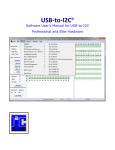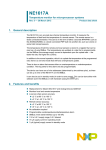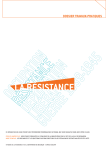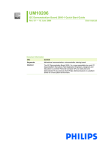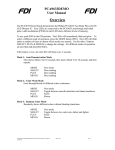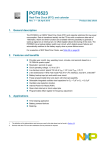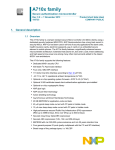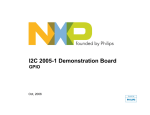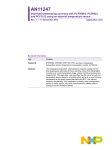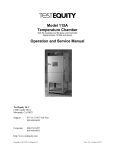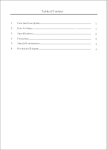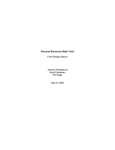Download user.manual.2005-1.t..
Transcript
I2C 2005-1 Demonstration Board Temperature Sensors Oct, 2006 Local versus Remote Temperature Sensors Local Temperature Sensor Senses own die temperature Local & Remote Temperature Sensor Senses own die temperature AND that of the remote diode sensor Remote Diode Sensor Part# Local Sensor Accuracy Remote Sensor Accuracy Part# Accuracy SMBUS TIMEOUT LM75A + 2 oC NO NE1617A + 2 oC + 3 oC SE95 + 1 oC NO NE1619* + 3 oC + 5 oC SE98 + 2 oC YES SA56004 + 2 oC + 1 oC Note: * with voltage monitors 2 I2C 2005-1 Demonstration Board Oct, 2006 SE98 Local Temperature Sensor Local temperature sensor compliant to JEDEC JC42.4 SE98 accuracy of ±2 oC (75 to 90 oC) 11-bit (0.125 °C) resolution With SMBus TIMEOUT & Security lock bits 8 Hz minimum conversion rate 0 °C, 1.5 °C, 3 °C, 6 °C programmable hysteresis threshold EVENT# output associated with 3 alarms: upper, lower and critical Block Diagram Security lock bit for data protection Operating voltage range from 3.0 V to 3.6 V 11-bit ΔΣ A-D-C A0 Maximum operating current: 250 µA A1 Programmable SMBus Alert Response and TIMEOUT A2 Operating temperature range from –20 °C to +125 °C 3 programmable I2C address pins: 0011 [A2 A1 A0] GND VDD EVENT Security Lock Bits 2-wire SMBus or I2C-bus standard/fast mode compatible Temperature Register CriticalTemperature OverTemperature UnderTemperature Configuration Control Logic 2-wire I2C/ SMBus Interface SCL SDA Offered in TSSOP8 and HVSON8* package *Note: 3mm x 3mm 3 I2C 2005-1 Demonstration Board Oct, 2006 Excellent Accuracy Characteristic SE98 Temperature Accuracy 25 Devices Tested @VCC = 3.3 V From 25 Devices • Temperature accuracy is well controlled over the entire temperature range 1.5 1 0.5 0 -0.5 • Lot to lot variation may shift the accuracy up or down -1 -1.5 120 100 Temperature (oC) 80 60 40 20 0 -2 -20 Temperature Accuracy (oC) 2 4 I2C 2005-1 Demonstration Board Oct, 2006 Temperature Accuracy Versus Resolution Temperature Resolution Temperature Accuracy Accuracy and error are used synonymously, and is the measure of how precisely the temperature sensor reading matches the ambient temperature Is the measure of temperature sensor’s smallest measuring step Example of 0.125 °C resolution Example: ±2 °C accuracy Measured Temperature Actual measured Temperature 75.125 °C 73 oC 75 oC 75 oC + 2 oC 77 oC Ambient Temperature 5 I2C 2005-1 Demonstration Board Oct, 2006 Comparator versus Interrupt Mode Comparator mode: EVENT output is cleared by itself once the temperature drops below the setpoints Interrupt mode: EVENT output is latched and only cleared by writing to the clear event bit 6 I2C 2005-1 Demonstration Board Oct, 2006 Configuration Register Critical Lock Bit 0: alarm register not locked, register value can be changed 1: alarm register locked , register value cannot be changed ALARM Lock Bit 0: Alarm not locked, upper and lower alarm can be modified 1: Alarm locked, upper and lower alarm cannot be modified Clear EVENT flag 0: no effect Hysteresis for alarm 1: clear the event flag in interrupt 00: mode hysteresis disabled 01: hysteresis = 1.5 °C 10: hysteresis = 3 °C 11: hysteresis = 6 °C 0: Temp sensor shutdown mode 1: Normal mode Register is 2 Byte EVENT Status bit 0: not asserted EVENT output control bit 1: asserted 0: EVENT output disabled 1: EVENToutput enabled Critical EVENT Only 0: Critical+Alarm 1: Critical EVENT Polarity 0: Active low 1: Active high EVENT Mode 0: Comparator mode 1: Interrupt mode 7 I2C 2005-1 Demonstration Board Oct, 2006 SE98 Registers 8 I2C 2005-1 Demonstration Board Oct, 2006 Temperature Data Register Above Critical indicates whether the temperature exceeds the critical temperature 0: temp is below critical temperature 1: temp exceeds critical temperature Above ALARM window indicates whether the temperature exceeds the alarm temperature 0: temperature is below the upper alarm 1: temperature exceeds the upper alarm Register is 2 Byte Below ALARM Window indicates whether the temperature falls below the lower alarm 0: temperature is above the lower alarm Sign bit 1: temperature falls below the Lower ALARM 0: positive temperature 1: negative temperature 1 1 1 1 Integer Decimal Reserved for future use Temperature Value = 25.125 oC 9 I2C 2005-1 Demonstration Board Oct, 2006 SE98 Training Board Schematic PCA9541/01 SE98 Address: 0x30 EVENT Output LED Visual status: Interrupt input and outputs 10 I2C 2005-1 Demonstration Board Oct, 2006 Training Board: Hardware Introduction 11 I2C 2005-1 Demonstration Board Oct, 2006 SE98 Software GUI Device Æ Thermal Management Æ SE98 Temperature Reading Alarm Status bits Cyclic Read Device Address Configuration & Status Registers Auto write Alarm setpoints 12 I2C 2005-1 Demonstration Board Oct, 2006 SE98 Hands-On: Device Initialization Set critical boundary alarm trip to 80 °C boundary registers Set hysteresis to 1.5 °C Set upper boundary alarm trip to 27 °C Enable /EVENT output Autowrite ON Transmission Successful Indicates SE98 responding 13 I2C 2005-1 Demonstration Board Oct, 2006 SE98 Hands-on (2) – EVENT output in Comparator versus Interrupt Mode 1. Visually check EVENT LED – it should be OFF 2. Click on the “Cyclic read” for continuous temperature update 3. Heat up or place your finger over the SE98 for a few minutes for temperature to exceed 28 °C, the EVENT LED is ON 4. Cool down or remove your finger from the SE98 and wait for a 1 minute or 2 until the temperature drops below 28 °C – What happens to the EVENT LED now? • 5. Change the EVENT output to Interrupt mode and repeat steps 1-4. – What happens to the EVENT LED now? • 6. EVENT LED is OFF EVENT LED is still ON Clear the EVENT bit. • EVENT LED is OFF Conclusion? – Comparator mode, the EVENT output de-asserted and LED is OFF when temperature falls within the ALARM window – Interrupt mode, the EVENT output stays asserted and LED is ON even after the temperature drops back within the ALARM window. The output is cleared by writing to the “event clear bit” 14 I2C 2005-1 Demonstration Board Oct, 2006 SE98 Hands-on (cont.) – Security lock bits 1. Read the upper, lower and critical alarm boundary trips registers. What are their values? Upper = 28 oC; Lower = 0 °C; Critical = 85 °C 2. Change the upper, lower and critical alarm boundary trip to 35 °C, -20°C, and 125 °C and read them back. What are their values? Upper = 35 °C Lower = - 20 °C Critical = 125 °C 3. Check the “lock the Critical” and “lock alarm window” bits 4. Change the upper, lower, and critical alarm boundary trips to 28 °C, 0 °C, and 85 °C, and read them back. What are their values? No change 5. Remove the power will reset remove the lock feature Conclusion: lock bit protects alarm setpoint values. Once lock bit is written, you can only clear it by powering off the SE98. 15 I2C 2005-1 Demonstration Board Oct, 2006 Expert Mode Exercise Power off and on the board Use the Expert Mode, write and verify the following codes: 1. 2. 3. 4. 5. 6. 7. 8. Set the upper alarm to 27 °C Confirm what you wrote is correct Set the critical temperature to 70 °C Confirm what you wrote is correct Write to configuration register to enable the EVENT output Read what you’ve just wrote Heat up SE98 and read the configuration register Read the temperature value 16 I2C 2005-1 Demonstration Board Oct, 2006 Solution 17 I2C 2005-1 Demonstration Board Oct, 2006 SA56004 Local & Remote Temp Sensor Monitors remote and local temperatures Accuracy of ±1 °C remote temperature sensing 11-bit ADC or 0.125 °C resolution Offset registers for the remote sensing accuracy ALERT#/T_CRIT# output for interrupt/fan control (on/off) 2-wire SMBus, or I2C standard/fast mode compatible +1 oC Accuracy With fan control Supports SMBus ALERT Response and TIMEOUT One-shot control for power saving Programmable Fault Queue Diode fault detection Up to 8 different device addresses Offered in TSSOP(MSOP)8 and SO8 packages 18 I2C 2005-1 Demonstration Board Oct, 2006 SA56004 Block Diagram 19 I2C 2005-1 Demonstration Board Oct, 2006 SA56004 Registers 20 I2C 2005-1 Demonstration Board Oct, 2006 Configuration and Status Registers Configuration Register (1 Byte) Write addr = 09h; Read addr = 03h Status Register (1Byte) Read addr = 02h; Write addr = N/A 21 I2C 2005-1 Demonstration Board Oct, 2006 SA56004 Training Board Schematic ALERT T_CRIT Connects To PCA9538 Port 7 and 8 PCA9538 ALERT Status LEDs T_CRIT Status LEDs SA56004 22 I2C 2005-1 Demonstration Board Oct, 2006 SA56004 Software GUI Device Address 0x98 Local Temperature Remote temperature Status Reg Temperature HIGH/LOW Limits Config Reg Critical Temperature Limit Conversion rate Autowrite Offset reg Cyclic read 1-shot 23 I2C 2005-1 Demonstration Board Oct, 2006 SA56004 Exercise 1. Select “cyclic read” 2. Read the status and configuration registers. What are the bits? – all bits should be clear 3. Set the remote high set-point register to 50 °C, 4. Set remote low set-point to 10 °C, and remote T_CRIT to 60 °C 5. Place the remote sensor diode in the hot water and record the remote temperature reading 6. Read the status register. Which bit is asserted? – External high temp bit is set 7. Place the remote sensor diode in a cup of ice water for 2 minutes or more 8. Read the status register. Which bit(s) is asserted? – External low temp bit is set 9. Read the local temperature value – Room temperature 10. Put the device in standby mode, place your finger over the SA56004, What happens to the local and remote temperature reading? – No change 11. Keep the finger on the SA56004 and click on the one-shot push button. What happens to the local and remote temperature reading? – Updated to your body temperature 24 I2C 2005-1 Demonstration Board Oct, 2006 Expert Mode Exercise Power on and off the board Use the expert mode, write and verify the following codes: 1. 2. 3. 4. 5. 6. 7. Program SA56004 to standby (STOP) mode in the configuration register Program the pointer to the remote temperature register high byte Read the remote temperature data register high byte Program the pointer to the remote temperature register low byte Read the remote temperature data register low byte Issue a one-shot command Read the remote temperature data high and low byte (repeat steps 3 and 5) 25 I2C 2005-1 Demonstration Board Oct, 2006 Solution 26 I2C 2005-1 Demonstration Board Oct, 2006 Temp Sensors Selection Table Voltage Remot Monitor e/Local Local Part# Tem perature range Accuracy Resolution Local Rem ote Pow er Supply Range Supply current Operting Shutdow n 2.7 V to 5.5 V 1 mA 3.8 μA 2.8 V to 5.5 V 1 mA 7.5 μA N/A +-1 oC +-3 oC +-1 oC 0.125 oC / LSB 0.03125 oC / LSB 0.125 oC / LSB 0.125 oC / LSB 1 oC / LSB 0.125 oC / LSB to 3.6 V to 3.6 V to 5.5 V to 3.6 V 100 μA 500 μA 70 μA 80 μA 10 μA 3.5 μA 3 μA +-3 oC 1 oC / LSB 2.8 V to 5.5 V 500 uA 100 μA LM75A -55 oC to 125oC +-2 oC N/A SE95 -55 oC to 125oC +-1 oC N/A SE98 SA56004 NE1617A NE1618 -20 oC to 125oC -55 oC to 125oC -55 oC to 125oC -55 oC to 125oC +-2 oC +-2 oC +-2 oC +-2 oC NE1619 -55 oC to 125oC +-5 oC 3.0 V 3.0 V 3.0 V 3.0 V 27 I2C 2005-1 Demonstration Board Oct, 2006 Temperature Sensor Applications CONSUMER COMMUNICATION COMPUTING/STORAGE PC SO-DIMM INDUSTRIAL Laptop Server 28 I2C 2005-1 Demonstration Board Oct, 2006





























